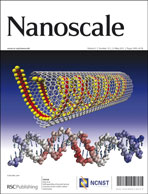We report the systematic control of the morphology of β-NaYF4:Yb,Er/Tm upconversion nanophosphors (UCNPs) from large spheres (37.9 nm) to rods (length = 60.1 nm, width = 21.5 nm) and from rods to hexagonal prisms (length = 48.8 nm, width = 44.0 nm) or small spheres (14.0 nm) by the use of a surfactant, an additive, and lanthanide doping. Increasing the ratio of oleic acid (OA) to 1-octadecene (ODE) caused a decrease in the size of the UCNPs, and increasing the OA/ODE ratio above a critical value caused the particle shape to change from a sphere to a rod. The length-to-width aspect ratio (AR) of upconversion nanorods (UCNRs) was finely manipulated from 1.28 to 2.80. The rounded tips of the UCNRs were flattened by adding Cl− ions, and the UCNRs changed to hexagonal prisms with a controllable AR depending on the quantity of Cl− ions. Additionally, the morphology of the β-NaYF4-based UCNPs was controlled by lanthanide doping. The size and AR of the UCNRs decreased with Gd3+ doping, and the UCNRs ultimately transformed into small spheres (14.0 nm) with high monodispersity. Doping with Ce3+ ions also decreased the AR of the UCNRs from 2.80 to 1.27. In addition, highly transparent polymer composites for 3D volumetric displays were fabricated by blending high-AR β-NaYF4:Yb,Er/Tm UCNRs with polydimethylsiloxane. These composites exhibited bright green and blue upconversion light during excitation with 980 nm light.

You have access to this article
 Please wait while we load your content...
Something went wrong. Try again?
Please wait while we load your content...
Something went wrong. Try again?


 Please wait while we load your content...
Please wait while we load your content...